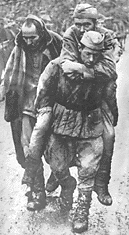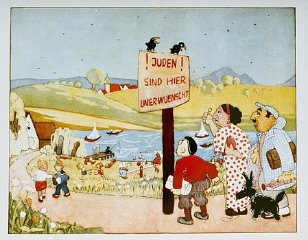|
Germany Invades Poland |
 When Hitler invaded
Poland in September 1939, France and Britain declared war on Germany.
After conquering Poland, Germany attacked France. France fell in June
1940, and soon the Nazis overran most of the rest of Europe and North
Africa. Only Britain, led by Winston Churchill, was not defeated. When Hitler invaded
Poland in September 1939, France and Britain declared war on Germany.
After conquering Poland, Germany attacked France. France fell in June
1940, and soon the Nazis overran most of the rest of Europe and North
Africa. Only Britain, led by Winston Churchill, was not defeated.
Click on the map for audio
and animated map description
from the U.S. Holocaust Museum
View World War II historical film footage
from the U.S. Holocaust Museum
Germany invades Poland - German film clip
Fall of Warsaw - British film clip
Swastika flag rises over Versailles and
Paris - German film clip
Germans bomb Coventry, England - English film clip
Japan attacks Peal Harbor - American film clip
US enters WWI - Roosevelt's "date that shall live in infamy" speech
Truman declares Victory in Europe - American film clip
Download RealPlayer
 |
|
Battle of Midway |
| Following the attack
on Peal Harbor, Japanese armies rolled over Southeast Asia, the
Philippines, and the East Indies. The war in the Pacific was fought on
land, at sea, and in the air. The turning point in the war in the Pacific
came in June, 1942 at the Battle of Midway. In a four day battle fought
between aircraft based on giant aircraft carriers, the U.S. destroyed
hundreds of Japanese planes and regained control of the Pacific. The
Japanese continued to fight on, however, even after the war in Europe
ended. |
|
Stalingrad |
|
On June 22, 1941, four million
troops poured over the Russian border. Within one month, over two
and half million Russians had been killed, wounded or captured. The
Germans made tremendous advances into Russia – into portions of
Moscow, Leningrad, and Stalingrad. into Russia – into portions of
Moscow, Leningrad, and Stalingrad.
And then winter hit. The Germans
were caught in summer uniforms, and it was a bitter, cold winter that
year.
Stalin, using sheer force of
numbers, threw another two million soldiers at the Germans.
The German offensive sputtered,
and then stopped. The German army was
about 1,800 miles away from home, and the railroads did not work.
In the spring of the next year
(1943),
another German offensive was launched especially around the approaches
to Stalingrad. What followed can only be described as a nine-month
titanic battle, with the result that the German Sixth Army in Russia
was almost completely destroyed. That was the beginning of the end for
Germany, but it would take three more years of desperate fighting, and
millions and millions of people dead before it was all over.
|
|
|
D-Day |
| On D-Day, June 6,
1944 , General Dwight Eisenhower led U.S. and Allied troops in an invasion
of Normandy, France. The armies fought their way through France and
Belgium and into Germany while Russian troops fought from the east. On May
7, 1945, Germany surrendered. |
|
Hiroshima and Nagasaki |
| The Japanese fought
on even after the war in Europe ended. Truman decided to use the newly
developed atomic bomb to end the war quickly and prevent more U.S.
casualties. The Enola Gay dropped an atomic bomb on Hiroshima, Japan
on August 6, 1945, killing about 78,000 people and injuring 100,000 more.
On August 9, a second bomb was dropped on Nagasaki, Japan, killing another
40,000 people. |
|
Anti-semitism |
 |
|
In part, the Nazi party gained
popularity by disseminating
anti-Jewish propaganda. Millions bought Hitler's book
Mein Kampf (My Struggle), which called for the
removal of Jews from Germany.
With the Nazi rise to power in 1933,
the party ordered anti-Jewish boycotts, staged book
burnings, and enacted anti-Jewish legislation. In 1935,
the
Nuremberg Laws defined Jews by blood and ordered the
total separation of "Aryans" and "non-Aryans." On November
9, 1938, the Nazis destroyed synagogues and the shop
windows of Jewish-owned stores throughout Germany and
Austria (Kristallnacht). |
|
Germany,
1936
llustration from an anti-Semitic children's book. The sign reads
"Jews are not wanted here."
See
more photographs
|
United States Holocaust
Memorial Museum |
|
|
|
|
The Holocaust |
 |
 |
The Holocaust
Click on the map
for audio and animated map description |
| The Holocaust was
the systematic persecution and murder of approximately six million
Jews by the Nazi regime. The Nazis, who came to power in Germany in
January 1933, believed that Germans were "racially superior" and that
the Jews, deemed "inferior," were "unworthy of life." During the era
of the Holocaust, the Nazis also targeted other groups because of
their perceived "racial inferiority": Roma (Gypsies), the handicapped,
and some of the Slavic peoples (Poles, Russians, and others).
In 1933, the Jewish population
of Europe stood at over nine million. By 1945, close to two out of
every three European Jews had been killed as part of the "Final
Solution", the Nazi policy to murder the Jews of Europe. |
|
| |
| |
 When Hitler invaded
Poland in September 1939, France and Britain declared war on Germany.
After conquering Poland, Germany attacked France. France fell in June
1940, and soon the Nazis overran most of the rest of Europe and North
Africa. Only Britain, led by Winston Churchill, was not defeated.
When Hitler invaded
Poland in September 1939, France and Britain declared war on Germany.
After conquering Poland, Germany attacked France. France fell in June
1940, and soon the Nazis overran most of the rest of Europe and North
Africa. Only Britain, led by Winston Churchill, was not defeated.  into Russia – into portions of
Moscow, Leningrad, and Stalingrad.
into Russia – into portions of
Moscow, Leningrad, and Stalingrad.

